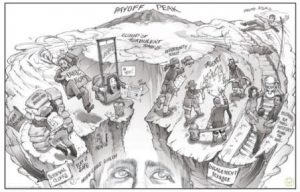If customer acquisition were always easy, business would be a cakewalk.
If acquiring new customers were simple, there would be no books, conferences or the need for B2B marketing organizations to develop a defined strategy. However, managing the costs and methods for customer acquisition and retention is a challenge for everyone.
Molly Galetto, VP Marketing Communications at NG Data, defines customer acquisition management as the “set of methodologies and systems for managing customer prospects and inquiries that are generated by a variety of marketing techniques.” In addition to marketing, a full-funnel mindset about customer acquisition will involve alignment with sales and customer success teams.
Customer acquisition can include a number of techniques that are familiar to demand marketers, such as audience targeting, lead scoring and reporting. If one or more of the tactics within a customer acquisition strategy is missing or ineffective, the whole program can miss targets. To learn the root cause of your struggles, it’s a valuable exercise to consider some of the symptoms of a sick customer acquisition strategy.
11 Symptoms of Sick Customer Acquisition
1. Poorly Defined Strategy Goals
Customer acquisition struggles can tank business results in record time. In many cases, it all boils down to an ineffective customer acquisition strategy, or a lack of goals.
James Dickerson, Founder & CEO of Crush Campaigns, writes that customer acquisition strategy goals should generally encompass targets for each of the following:
- Lead generation
- Product/service inquiries
- Conversions
- Website traffic
In addition to these top-of-funnel metrics, the customer acquisition strategy should also measure potential revenue in the pipeline, and create targets for revenue and recurring revenue that are shared by marketing, sales and customer success.
2. Team Members Aren’t Working in the Right Roles
Your customer acquisition strategy won’t take flight if your talent isn’t sitting in the right seats on the bus. Aligning people with strategy is a challenge for any B2B marketing organization, and there’s a number of ways ineffective talent management can result in an ailing strategy.
- Maybe you have the talent needed, but your people need training or their job roles don’t align with your program goals.
- Perhaps you’ve got a dream team, but your human resources are tied up in manual tasks.
- Alternatively, maybe you really don’t have enough talent and you need more bodies.
These challenges aren’t unique, but they can have a real, negative impact on customer acquisition. If your issues resemble any of the possibilities above, you have a serious case for training, outsourcing, hiring or technology to automate your manual tasks.
To make matters worse, there’s no single blueprint for what a customer acquisition team and team roles “should” look like. Some tiny companies may drive results with a team of four; for example, demand gen, product marketing, content and PR/communications. Others may have dozens of internal team members and external third-party agencies.
The most effective way to ensure you have the right people working towards the right goals is to develop a healthy strategy, break down your goals into campaigns and assets and then divide the work across your existing team members’ strengths. In a modern marketing environment, it’s natural that roles can evolve quickly to support new initiatives.
3. You’re Missing the Target on Audience
All too often, a struggling customer acquisition strategy can be attributed to targeting troubles. Do you know who you’re targeting and why?
For teams that are already using customer acquisition tactics, baseline measurement probably has value. Renée Warren, Co-Founder and Public Relations Specialist at Onboardly, writes in Kissmetrics:
“There are two audiences you need to keep in mind here: your current audience and your ideal audience. Your current audience is self-explanatory; it’s the audience you are reaching already. Your ideal audience is the group you would like to reach eventually.”
Using tools for web and social media analytics and lead management, measure your current audience. Use this knowledge to measure who you’re reaching and how it stacks up to your buyer persona profiles. With a knowledge of how your targeting techniques are failing and succeeding, you can improve your content targeting, owned and paid distribution, and campaign efforts to reach the right people.
4. Content isn’t Being Executed Properly
Simply having content isn’t enough for a healthy customer acquisition strategy. It needs to be used in the right ways, distributed on the right paid and owned channels, and aligned with the overall customer acquisition and demand generation strategies. While content isn’t simple, far from it, it can be a powerhouse component of your demand generation strategy when used effectively.
David Stone, Manager of Content Marketing at ROI Revolution, writes on Windsor Circle that “content marketing….if done well…can have a huge positive effect on both customer acquisition and retention.”
Using content in the right ways for acquisition involves:
- Researching buyer personas and their content habits
- Translating campaign into content assets
- Orchestrating a plan for content distribution
- Performing continual analysis of content performance
5. Nurturing isn’t Orchestrated Optimally
Customer nurturing is the act of building relationships with your leads, to turn opportunities into long-term relationships. Nurturing involves the orchestration of people, processes and technologies. You may recognize that your nurturing is a point of weakness if you’re losing sales to your competition, your marketing-qualified leads rarely convert into sales-qualified leads, or lead-to-customer close rates are abysmal. Components of a healthy lead nurturing strategy involve:
- Strong knowledge of the customer journey
- Technologies to automate lead nurturing, such as marketing automation platforms and lead processing
- Content assets and messaging tailored to specific stages of the buy-cycle
6. Measurement isn’t Informing Action
It’s rare that marketers aren’t measuring.
More commonly, marketers measure too much or too little. They’re wrapped up in social media engagement methods and ignoring high-return measurement across the lead sources for the top of the funnel.
In other cases, marketers wish they could measure success rates across lead sources, but without technologies to unify their efforts, they’re stuck trying to perform time-consuming data reconciliations in Excel.
Full-funnel measurement matters. So does unified measurement.
At a high level, the following metrics illustrate some of the insights B2B marketers need for an appropriately measured customer acquisition strategy:
- Cost of customer acquisition
- Customer lifetime value
- Customer churn rate
- Viral coefficient (organic lead generation and customer conversion)
- Customer acquisition and engagement
- Customer referrals
7. Troubled Relationships with Sales
Your customer acquisition strategy won’t be in full focus if sales and marketing are in a state of active war. Poor communication or alignment can result in a number of scary symptoms, which range from targeting the wrong leads to poorly synchronized lead handoffs or even sales team resistance against marketing efforts to work in tandem.
Christina O’Conner, Marketing Manager at LinkedIn, writes that a 2017 global LinkedIn research project on sales-marketing alignment titled The Power Couple recently uncovered “a vast majority of businesses (74%) [report] some forward progress on sales and marketing alignment, [but] far fewer describe it as ‘much better’ than a year ago.”
The same LinkedIn study found the following actions are associated with superior customer acquisition strategy performance, including data on how frequently these actions were reported by best-of-class survey respondents:
- Shared objectives and KPIs ( 52%)
- Superior customer insights (52%)
- Accountability and clear workflows (47%)
- Scheduled, consistent team meetings (45%)
8. Content Distribution Troubles
Did your latest eBook result in a total of three downloads? Is your lead quality abysmal? Do you struggle with a high average lead cost, since your paid distribution channels aren’t always putting your content in front of audiences that are qualified to become sales opportunities? If so, all signs point to content distribution trouble.
You can’t acquire new customers without quality content. You may be able to see some customer acquisition success with unbalanced distribution efforts, but you’re not maximizing the ROI of your content assets. A healthy content distribution strategy for your firm may involve:
- Targeted content distribution via the right syndication partnerships
- Smart content repurposing for impact with personas
- Retargeting prospects in the middle of the sales funnel with content
- Improving distribution efforts with face-to-face insights from sales and customer success
- Data-informed customer segmentation for more precise distribution
- Using tools, processes and education to support sales success with easy access to middle and bottom of the funnel content assets
9. Manual, Messy Lead Processing
If you spend hours each week pouring over spreadsheets to manually format lead data to be uploaded to your MAP or CRM, you’re in the majority. If your sales team complains of low-quality lead data – like untargeted job titles or faulty emails – you’re also normal. While “dirty data” and heavily manual lead processing efforts are common, they’re not a part of a healthy customer acquisition strategy.
Integrate research has found that up to 45% of lead records contain bad data, including most commonly, duplicated data, bad field data, missing fields or invalid formatting. This “dirty data” makes it impossible to measure performance. Spending hours each week tweaking low quality leads for upload into your CRM isn’t the smartest use of marketing team resources.
In contrast, what does a healthy lead processing program that’s based on the smartest technologies look like? At best-of-class firms, lead processing efforts involve technologies that support:
- Automation of lead processing from third-party lead sources
- Lead quality review to avoid paying for bad leads
- Automation of data standardization to eliminate manual work
- Consolidated, automated lead data upload to MAP and/or CRM tools
10. Stagnant Lead Scoring Systems
Lead scoring is simple, right? While technologies have made it relatively easy for marketing and sales to implement shared lead qualification criteria and automate the processes used to qualify opportunities, many companies are suffering from stagnant lead scoring systems. While the old-school method of doing things may work for a time, it won’t help you reach heightened customer acquisition goals.
Issues with lead scoring processes can even lead to other struggles, including worsened sales-marketing alignment. Elyse Dupre, a Writer at E! Networks and former Special Features Editor at DM News writes that “imperfections often create contention between marketers and their sales colleagues.”
Here are some tactics that can contribute to mature lead scoring processes:
- Develop collaborative processes for continual sales-marketing improvement
- Creating a neutral “owner” for lead scoring processes and tools, such as marketing ops
- Integrate predictive analytics tools to enhance scoring to include intent and propensity to buy
- Incorporate measurement of lead velocity for smarter nurturing and sales actions
- Use lead scoring technologies on existing customers to upsell and cross-sell
- Move from lead scoring to firmographic scoring with account-based marketing (ABM) techniques
- Optimize and experiment with scoring criteria for continual improvement
- Inform full-funnel marketing efforts with closed-loop intelligence
11. Weak Reporting & Optimization Processes
Are you spending hours with your demand generation and marketing operations specialists trying to figure out what’s working at the top of the funnel and how to improve performance?
It’s common, and even worse, you may not recognize this as a symptom of a sick customer acquisition strategy because it feels productive. The problem is that top-funnel customer acquisition efforts are too often disconnected from lower-funnel conversion metrics. You can report and optimize, but it’s not efficient.
This is a process challenge that’s often best solved with technologies for closed-loop key performance indicator (KPI) reporting, which allow data from your MAP and CRM to be reported as prospects travel through your sales pipeline.
A mature reporting and optimization process will allow oversight over campaigns, sources, creative and audiences, including real-time insights into:
- Marketing-qualified and sales-accepted leads
- Leads and firms from target accounts list
- Opportunities and closed opportunities
- Customer lifetime value
Healing Your Customer Acquisition Strategy
The root causes of these common symptoms of a sick customer acquisition strategy can vary significantly. In some cases, such as ineffective measurement or lead processing, marketers are trying to do the right things but lack the right technologies for efficiency. In other cases, marketers may need to hire more talent or work towards better cultural alignment with sales and customer success.
Not only is customer acquisition complex, but it also involves the orchestration of a lot of moving pieces, from MarTech to entire teams of people. By evaluating your B2B marketing and sales strategy holistically, you can determine how to achieve meaningful progress towards your goals in the year to come.
Unsure where or how your acquisition strategy is going wrong? For a comprehensive look at how your firm stacks up against best-of-class B2B organizations, check out: B2B Demand Marketing Assessment Guide & Orchestration Workbook. It includes everything you need for end-to-end diagnostics, including 12 customizable worksheets.
Business & Finance Articles on Business 2 Community
(47)
Report Post






